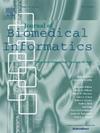ARCH: Large-scale knowledge graph via aggregated narrative codified health records analysis
IF 4
2区 医学
Q2 COMPUTER SCIENCE, INTERDISCIPLINARY APPLICATIONS
引用次数: 0
Abstract
Objective:
Electronic health record (EHR) systems contain a wealth of clinical data stored as both codified data and free-text narrative notes (NLP). The complexity of EHR presents challenges in feature representation, information extraction, and uncertainty quantification. To address these challenges, we proposed an efficient Aggregated naRrative Codified Health (ARCH) records analysis to generate a large-scale knowledge graph (KG) for a comprehensive set of EHR codified and narrative features.
Methods:
Using data from 12.5 million Veterans Affairs patients, ARCH first derives embedding vectors and generates similarities along with associated -values to measure the strength of relatedness between clinical features with statistical certainty quantification. Next, ARCH performs a sparse embedding regression to remove indirect linkage between features to build a sparse KG. Finally, ARCH was validated on various clinical tasks, including detecting known relationships between entity pairs, predicting drug side effects, disease phenotyping, as well as sub-typing Alzheimer’s disease patients.
Results:
ARCH produces high-quality clinical embeddings and KG for over 60,000 codified and narrative EHR concepts. The KG and embeddings are visualized in the R-shiny powered web-API.3 ARCH achieved high accuracy in detecting EHR concept relationships, with AUCs of 0.926 (codified) and 0.861 (NLP) for similar EHR concepts, and 0.810 (codified) and 0.843 (NLP) for related pairs. It detected drug side effects with a 0.723 AUC, which improved to 0.826 after fine-tuning. Using both codified and NLP features, the detection power increased significantly. Compared to other methods, ARCH has superior accuracy and enhances weakly supervised phenotyping algorithms’ performance. Notably, it successfully categorized Alzheimer’s patients into two subgroups with varying mortality rates.
Conclusion:
The proposed ARCH algorithm generates large-scale high-quality semantic representations and knowledge graph for both codified and NLP EHR features, useful for a wide range of predictive modeling tasks.

求助全文
约1分钟内获得全文
求助全文
来源期刊

Journal of Biomedical Informatics
医学-计算机:跨学科应用
CiteScore
8.90
自引率
6.70%
发文量
243
审稿时长
32 days
期刊介绍:
The Journal of Biomedical Informatics reflects a commitment to high-quality original research papers, reviews, and commentaries in the area of biomedical informatics methodology. Although we publish articles motivated by applications in the biomedical sciences (for example, clinical medicine, health care, population health, and translational bioinformatics), the journal emphasizes reports of new methodologies and techniques that have general applicability and that form the basis for the evolving science of biomedical informatics. Articles on medical devices; evaluations of implemented systems (including clinical trials of information technologies); or papers that provide insight into a biological process, a specific disease, or treatment options would generally be more suitable for publication in other venues. Papers on applications of signal processing and image analysis are often more suitable for biomedical engineering journals or other informatics journals, although we do publish papers that emphasize the information management and knowledge representation/modeling issues that arise in the storage and use of biological signals and images. System descriptions are welcome if they illustrate and substantiate the underlying methodology that is the principal focus of the report and an effort is made to address the generalizability and/or range of application of that methodology. Note also that, given the international nature of JBI, papers that deal with specific languages other than English, or with country-specific health systems or approaches, are acceptable for JBI only if they offer generalizable lessons that are relevant to the broad JBI readership, regardless of their country, language, culture, or health system.
 求助内容:
求助内容: 应助结果提醒方式:
应助结果提醒方式:


